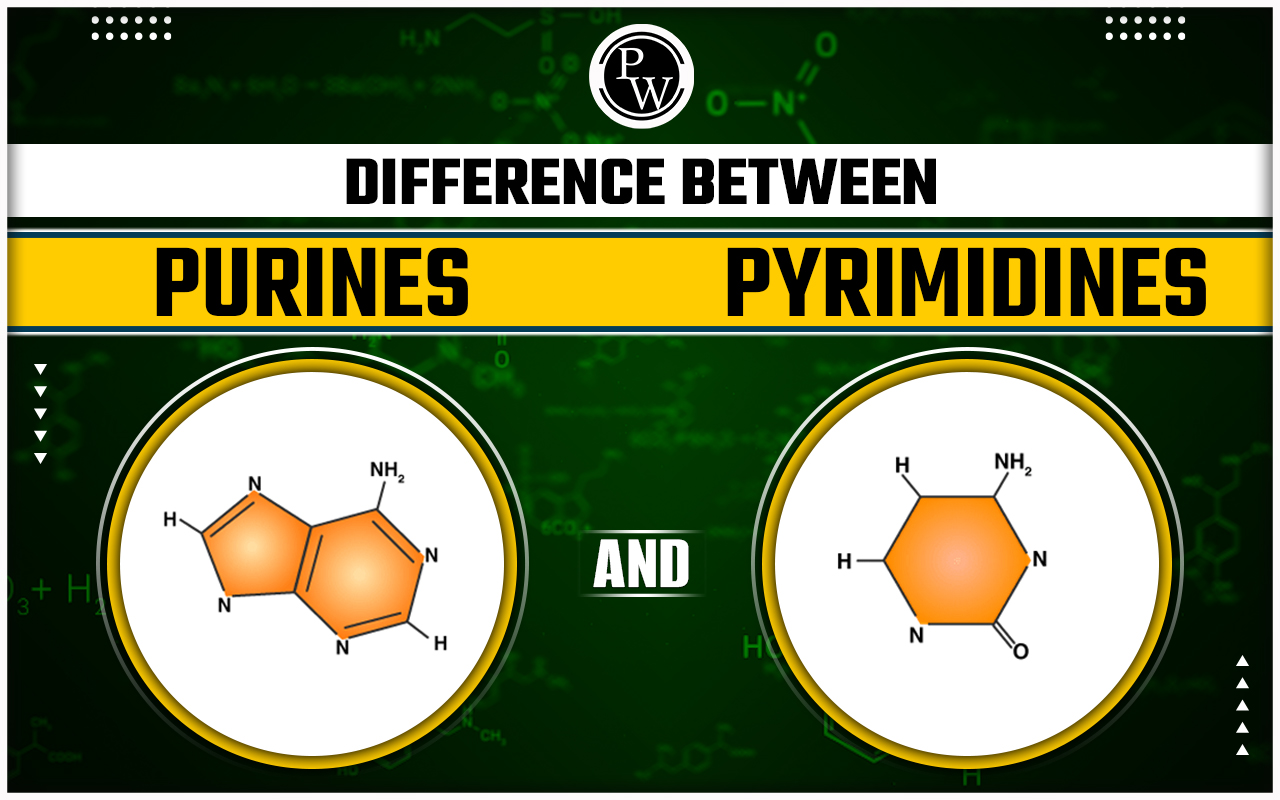

Difference between Purines and Pyrimidines: Purines and pyrimidines are two types of aromatic heterocyclic organic compounds, which are ring structures that contain nitrogen and carbon atoms. Both are similar to pyridine (C5H5N), an organic molecule related to benzene (C6H6) with one carbon atom replaced by nitrogen.
These compounds are important in organic chemistry and biochemistry because they are the foundation for many molecules, including caffeine, theobromine, theophylline, and thiamine. Furthermore, they are necessary components of nucleic acids like deoxyribonucleic acid (DNA) and ribonucleic acid (RNA). The article below discusses the difference between purines and pyrimidines.
Difference Between Purines and Pyrimidines Overview
Purines and pyrimidines are the two major types of nitrogenous bases required to form DNA and RNA, which carry genetic information. Understanding the difference between purines and pyrimidines is essential for understanding the structure and function of nucleic acids. Purines are nitrogenous bases found in RNA and DNA. They have a double-ring structure with six and five members, respectively. Adenine (A) and guanine (G) are the two purines found in RNA and DNA. These bases are essential for forming hydrogen bonds with their complementary counterparts, which helps to stabilize DNA's double helix structure.In contrast, pyrimidines are the other class of nitrogenous base found in DNA and RNA. They have a single ring structure made up of six rings. DNA and RNA contain three pyrimidines: cytosine (C), thymine (T), and uracil (U). Cytidine and thymine are found only in DNA, whereas cytosine and uracil can also be found in RNA. Nitrogenous base pairing rules state that adenine pairs with thymine (or uracil in RNA), while cytosine pairs with guanine. The detailed difference between purines and pyrimidines are provided in the article below.Difference Between Purines and Pyrimidines
Purine structure is primarily heterocyclic, with two carbon rings created by the union of pyrimidine and imidazole rings, as well as an aromatic compound with four nitrogen atoms. Pyrimidine, on the other hand, has heterocyclic properties because its aromatic compound only has two nitrogen atoms and one carbon ring. Purines and pyrimidines have different properties due to their intrinsic structural differences. The difference between purines and pyrimidines are explained in the table that follows:
| Difference Between Purines and Pyrimidines | ||
|---|---|---|
| Parameters | Purines | Pyrimidines |
| Origin | Adenine and guanine in DNA and RNA | Thymine in DNA; Uracil in RNA; Cytosine in RNA and DNA |
| Size | Larger | Smaller |
| Structure | Consists of pentose and hexose rings | Single hexo-cyclic ring |
| Chemical Formula | C5H4N4 | C4H4N2 |
| Solubility | Soluble in water | Insoluble in water |
| Catabolic End Product | Uric acid | Carbon dioxide, beta-amino acids, and ammonia |
| Melting Point | Higher (214°C) | Lower (22°C) |
| Molecular Mass | 120.115 g/mol | 80.08 g/mol |
| Biosynthesis Location | Liver | Various tissues |
| Structure | Double ring with one being pyrimidine | Single ring |
| Nitrogenous Bases | Adenine, guanine | Cytosine, uracil, thymine |
| Uses | DNA, RNA, vitamins, drugs, energy storage, protein and starch synthesis, cell signaling, enzyme regulation | DNA, RNA, drugs, energy storage, protein and starch synthesis, enzyme regulation, cell signaling |
Purines Definition
Purines are fundamental nitrogenous bases found in organisms' genetic material, which includes DNA and RNA. They exhibit a unique double-ring structure, consisting of a six-membered ring fused with a five-membered ring. The two purines found in DNA and RNA are adenine (A) and guanine (G), which play important roles in the stability of the DNA double helix by forming hydrogen bonds with complementary base pairs. Purines have the molecular formula C5H4N4, indicating that they are heterocyclic, with four nitrogen atoms and two carbon rings. This structure contains nitrogen atoms at specific locations within the rings, which contributes to purines' overall stability and functionality in biological processes. Purines fulfill essential metabolic functions within organisms with a melting point of 214 degrees Celsius and a molecular mass of 120.115 g/mol. They participate in DNA and RNA synthesis, regulate enzyme activity, and act as coenzymes in various biochemical reactions. Furthermore, purines help maintain metabolic homeostasis, regulate cell growth, facilitate sugar transport, and are essential components of proteins and starches.Pyrimidines Definition
Pyrimidines, like purines, are essential components of DNA and RNA and play an important role in genetic coding. These nitrogenous bases, which have a single-ring structure, cytosine, thymine, and uracil, help to transmit genetic information using specific base pairing rules. While cytosine and thymine are unique to DNA, cytosine pairs with guanine in DNA and RNA, whereas uracil replaces thymine in RNA. Pyrimidines are heterocyclic aromatic organic compounds with a single pyrimidine ring that contains two nitrogen atoms. They have a colorless chemical formula of C4H4N2, a melting point of 22 degrees Celsius, and a molecular mass of 80.088 grams per mole. Pyrimidines serve a variety of functions in biological processes, including forming nucleic acid building blocks and promoting DNA and RNA synthesis. They also contribute to metabolic pathways, facilitating polysaccharide and phospholipid synthesis while maintaining tissue integrity. Pyrimidines also serve as signaling molecules and enzyme regulators, influencing important biochemical reactions. Furthermore, their pharmacological utility includes antibiotics and therapeutic agents, highlighting their importance in physiological and pharmaceutical contexts.Physics Wallah’s NEET online coaching is a top choice for NEET UG preparation. PW offers a range of courses, including free coaching in multiple languages, with affordable fees, expert faculty, live and recorded classes, doubt-solving sessions, and study materials. Enroll now and start your NEET preparation!
Difference Between Purines and Pyrimidines FAQs
How does adenine differ from guanine?
What is the scope of Chargaff's rule?
How do adenine, guanine, thymine, and cytosine differ?
What is the basic structure of purines and pyrimidines?
What is the structure of DNA?












